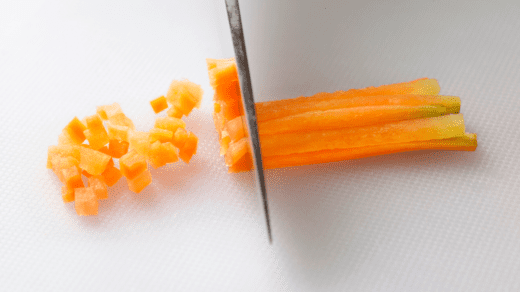Hey There! Some links on this page are affiliate links, which means that as an Amazon Associate, I may earn a small commission at no extra cost to you. I greatly appreciate your support! Learn more on my Affiliate Disclosure page.
Making your stock at home is a fantastic way to enhance the flavor of your dishes. Corn stock, in particular, brings a sweet, rich, and unique taste that elevates soups, stews, and sauces.
Plus, it’s an excellent way to use leftover corn cobs, making this recipe economical and environmentally friendly. In this guide, Chef Mark Sandoval will walk you through the process step-by-step, ensuring you can easily create delicious corn stock.
Why You Will Love This Recipe

There are several reasons to love making your own corn stock:
- Flavor Boost: Homemade corn stock is far more flavorful than store-bought options.
- Economical: Utilizing leftover corn cobs reduces waste and maximizes your grocery budget.
- Versatility: This stock can be used in a variety of recipes, from soups to risotto.
- Healthier: Control the ingredients to avoid preservatives and excess sodium found in commercial stocks.
Ingredients

Below is a table listing the ingredients you’ll need to make this delicious corn stock.
| Ingredient | Description |
|---|---|
| White Mirepoix | A mix of chopped onion, celery, and leek |
| Leek Tops | The green parts of the leeks |
| Blended Oil | 75% Canola oil, 25% Extra Virgin Olive oil |
| Corn Cobs | The cores of corn after the kernels are removed |
| Thyme | Fresh or dried |
| Parsley Stems | Stems of parsley, usually discarded |
| Black Peppercorns | Whole peppercorns for flavor |
Kitchen Tools

Here are the essential tools you’ll need, listed in a handy table format.
| Tool | Description |
|---|---|
| Kitchen Bowl | For holding chopped ingredients |
| Stockpot | A large pot for cooking the stock |
| Spatula | For stirring |
| Chinois | A fine-mesh strainer |
| Chef’s Knife | For chopping vegetables |
| Cutting Board | To chop the vegetables |
| Kitchen Towels | To keep your workspace clean |
Step-By-Step Corn Stock Instructions – VIDEO
Prepare the Vegetables
- Chop the onion, celery, and leek into medium-sized pieces to create the white mirepoix.
- Place them in the kitchen bowl.
- Set aside the leek tops for later use.
Heat the Oil
- In the stock pot, heat the blended oil over medium heat.
Cook the Mirepoix
- Add the white mirepoix (onion, celery, and leek) to the pot.
- Sauté until the vegetables are softened but not browned, which should take 5-7 minutes.
Add Corn Cobs and Herbs
- Add the corn cobs, thyme, parsley stems, and black peppercorns to the pot.
Add Water
- Pour enough water into the pot to cover all the ingredients. This usually means adding about 8-10 cups of water.
Simmer the Stock
- Bring the mixture to a boil, then reduce the heat to a simmer.
- Let it cook for about 45 minutes to 1 hour.
Strain the Stock
- Using the chinois, strain the stock into another container, discarding the solids.
Cool and Store
- Allow the stock to cool.
- Use kitchen towels to clean up any spills.
- Once cooled, store the stock in airtight containers in the refrigerator for up to a week or in the freezer for up to three months.
Tips, Tricks, and Storage Options

Enhance your corn stock with these expert tips and tricks, making the process easier and the flavor richer.
Tips
- Roast the corn cobs and vegetables before adding them to the stock pot for a richer flavor.
- Use fresh herbs if possible for a more vibrant taste.
Tricks
- Freeze the stock in ice cube trays for easy portioning.
- Add a splash of white wine for extra depth of flavor.
Storage Options
- Refrigerate the stock for up to one week.
- Freeze the stock for up to three months.
Conclusion

Making your corn stock is a simple and rewarding process that brings a depth of flavor to your cooking. It’s economical, sustainable, and allows you to control the ingredients. I encourage you to try this recipe in your favorite dishes.
Don’t forget to share your corn stock creations with us! Post your photos and tag us on social media. Subscribe to our blog for more delicious recipes and cooking tips.
Thank you for reading! Be sure to check back soon for more informative and exciting articles.
Happy cooking!
FAQs – Frequently Asked Questions

Can I use frozen corn cobs?
Yes, frozen corn cobs work well for this recipe. Just make sure to thaw them slightly before adding to the pot for even cooking.
What can I substitute for leek if I don’t have any?
You can substitute more onions or green onions. Both options will provide a similar aromatic base for your stock.
Can I make this stock in a slow cooker?
Yes, you can cook the stock in a slow cooker on low for 6-8 hours. This method is convenient and allows the flavors to develop deeply over time.
Is it necessary to use blended oil?
No, you can use either canola or extra virgin olive oil alone. Blended oil balances flavor and health benefits, but either oil will work fine.
Can I add other vegetables to the stock?
Absolutely, carrots and garlic are great additions to enhance the flavor. Feel free to experiment with other vegetables you have on hand.
How do I know when the stock is done?
The stock is done when it has a rich flavor, and the corn cobs have given up all their essence. It should have a deep, golden color and a fragrant aroma.
Can I reuse the corn cobs?
It’s not recommended, as they will have lost most of their flavor. For best results, discard the used cobs and start with fresh ones for each batch.
What dishes can I use corn stock in?
Use it in soups, risotto, or as a base for sauces to add a sweet, rich flavor. It’s versatile and can be substituted for vegetable or chicken stock in many recipes.
Can I pressure this stock?
Yes, but follow proper canning guidelines to ensure safety. Pressure canning is effective for preserving the stock for long-term storage.
Hey There! Some links on this page are affiliate links, which means that as an Amazon Associate, I may earn a small commission at no extra cost to you. I greatly appreciate your support! Learn more on my Affiliate Disclosure page.



























